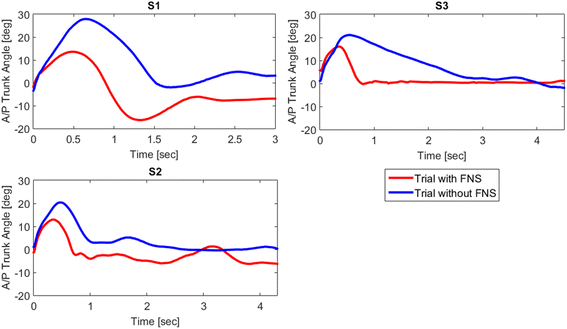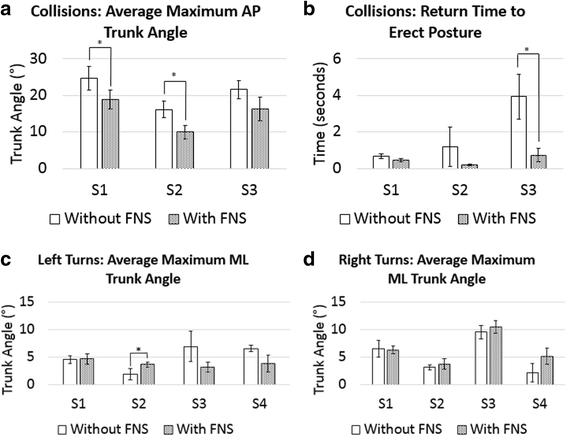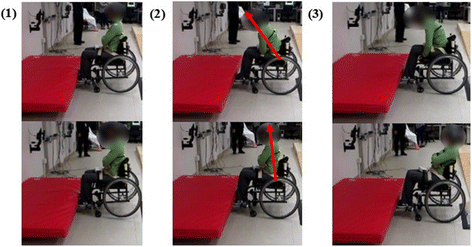Automatic application of neural stimulation during wheelchair propulsion after SCI enhances recovery of upright sitting from destabilizing events
- PMID: 29530053
- PMCID: PMC5848592
- DOI: 10.1186/s12984-018-0362-2
Automatic application of neural stimulation during wheelchair propulsion after SCI enhances recovery of upright sitting from destabilizing events
Abstract
Background: The leading cause of injury for manual wheelchair users are tips and falls caused by unexpected destabilizing events encountered during everyday activities. The purpose of this study was to determine the feasibility of automatically restoring seated stability to manual wheelchair users with spinal cord injury (SCI) via a threshold-based system to activate the hip and trunk muscles with electrical stimulation during potentially destabilizing events.
Methods: We detected and classified potentially destabilizing sudden stops and turns with a wheelchair-mounted wireless inertial measurement unit (IMU), and then applied neural stimulation to activate the appropriate muscles to resist trunk movement and restore seated stability. After modeling and preliminary testing to determine the appropriate inertial signatures to discriminate between events and reliably trigger stimulation, the system was implemented and evaluated in real-time on manual wheelchair users with SCI. Three participants completed simulated collision events and four participants completed simulated rapid turns. Data were analyzed as a series of individual case studies with subjects acting as their own controls with and without the system active.
Results: The controller achieved 93% accuracy in detecting collisions and right turns, and 100% accuracy in left turn detection. Two of the three subjects who participated in collision testing with stimulation experienced significantly decreased maximum anterior-posterior trunk angles (p < 0.05). Similar results were obtained with implanted and surface stimulation systems.
Conclusions: This study demonstrates the feasibility of a neural stimulation control system based on simple inertial measurements to improve trunk stability and overall safety of people with spinal cord injuries during manual wheelchair propulsion. Further studies are required to determine clinical utility in real world situations and generalizability to the broader SCI or other population of manual or powered wheelchair users.
Trial registration: ClinicalTrials.gov Identifier NCT01474148 . Registered 11/08/2011 retrospectively registered.
Keywords: Event detection; Functional neuromuscular stimulation; Spinal cord injury.
Conflict of interest statement
Ethics approval and consent to participate
All procedures performed in the current study which involved human participants were in accordance with the ethical standards of the institutional and/or national research committee and with the 1964 Helsinki declaration and its later amendments or comparable ethical standards.
Consent for publication
The subject signed consent for the data captured in the experiments to be used in a publication.
Competing interests
The authors declare that they have no competing interests.
Publisher’s Note
Springer Nature remains neutral with regard to jurisdictional claims in published maps and institutional affiliations.
Figures







References
-
- Spinal Cord Injury (SCI) Facts and Figures at a Glance. In: The National Spinal Cord Injury Statistical Center. The University of Alabama at Birmingham Department of Physical Medicine and Rehabilitation. https://www.nscisc.uab.edu/Public/Facts%20and%20Figures%20-%202017.pdf. Accessed 7 June 2017.
-
- Complete Public Version of the 2013 Annual Statistical Report for the Spinal Cord Injury Model System. In: The National Spinal Cord Injury Statistical Center. The University of Alabama at Birmingham Department of Physical Medicine and Rehabilitation. https://www.nscisc.uab.edu/PublicDocuments/reports/pdf/2013%20NSCISC%20A.... Accessed 7 June 2013.
-
- Milosevic M, Masani K, Kuipers MJ, Rahouni H, Verrier MC, McConville KM, Popovic MR. Trunk Control Impairment is Responsible for Postural Instability during Quiet Sitting in Individuals with Cervical Spinal Cord Injury. Clin Biomech (Bristol, Avon) 2015;30(5):507–512. doi: 10.1016/j.clinbiomech.2015.03.002. - DOI - PubMed
Publication types
MeSH terms
Associated data
Grants and funding
LinkOut - more resources
Full Text Sources
Other Literature Sources
Medical

